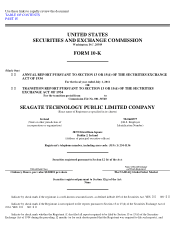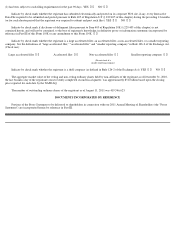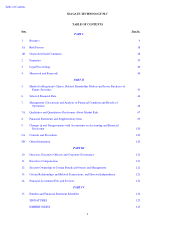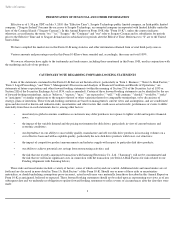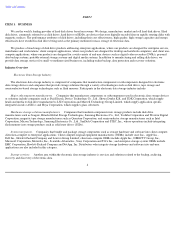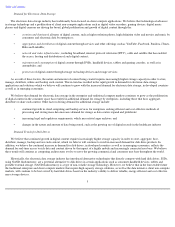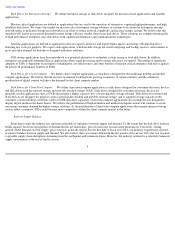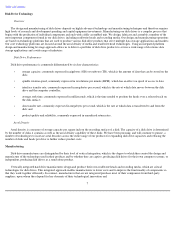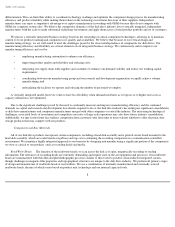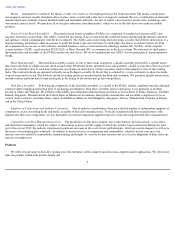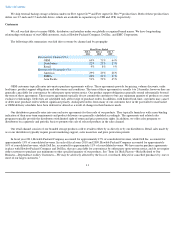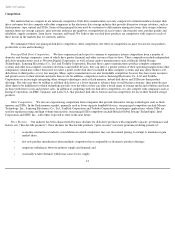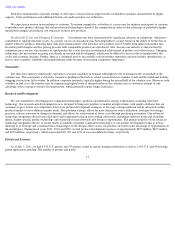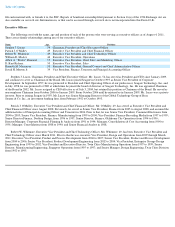Seagate 2010 Annual Report Download - page 12
Download and view the complete annual report
Please find page 12 of the 2010 Seagate annual report below. You can navigate through the pages in the report by either clicking on the pages listed below, or by using the keyword search tool below to find specific information within the annual report.
Table of Contents
Media. Information is written to the media, or disk, as it rotates at very high speeds past the read/write head. The media is made from
non-magnetic material, usually aluminum alloy or glass, and is coated with a thin layer of magnetic material. We use a combination of internally
manufactured and externally sourced finished media and aluminum substrates, the mix of which varies based on product mix, technology and
our internal capacity levels. We purchase all of our glass substrates from third parties, which we use in the disk drives we make for mobile
products.
Printed Circuit Board Assemblies. The printed circuit board assemblies (PCBAs) are comprised of standard and custom ASICs and
ancillary electronic control chips. The ASICs control the movement of data to and from the read/write heads and through the internal controller
and interface, which communicates with the host computer. The ASICs and control chips form electronic circuitry that delivers instructions to a
head positioning mechanism called an actuator to guide the heads to the selected track of a disk where the data is recorded or retrieved. Disk
drive manufacturers use one or more industry standard interfaces such as serial advanced technology architecture (SATA); small computer
system interface (SCSI); serial attached SCSI (SAS); or Fibre Channel (FC) to communicate to the host systems. We outsource to third parties
the manufacture and assembly of the PCBAs used in our disk drives. We do not manufacture any ASICs, but we participate in their proprietary
design.
Head Disk Assembly. The head disk assembly consists of one or more disks attached to a spindle assembly powered by a spindle motor
that rotates the disks at a high constant speed around a hub. Read/write heads, mounted on an arm assembly, similar in concept to that of a record
player, fly extremely close to each disk surface and record data on and retrieve it from concentric tracks in the magnetic layers of the rotating
disks. The read/write heads are mounted vertically on an E-shaped assembly (E-block) that is actuated by a voice-coil motor to allow the heads
to move from track to track. The E-block and the recording media are mounted inside the head disk assembly. We purchase spindle motors from
outside vendors and from time to time participate in the design of the motors that go into our products.
Disk Drive Assembly. Following the completion of the head disk assembly, it is mated to the PCBA, and the completed unit goes through
extensive defect mapping and testing prior to packaging and shipment. Disk drive assembly and test operations occur primarily at facilities
located in China and Thailand. We perform subassembly and component manufacturing operations at our facilities in China, Malaysia, Northern
Ireland, Singapore, Thailand and in the United States in Minnesota. In addition, third parties manufacture and assemble components for us in
various Asian countries, including China, Japan, South Korea, Malaysia, the Philippines, Singapore, Taiwan, Thailand and Vietnam, in Europe
and in the United States.
Suppliers of Components and Industry Constraints. Due to industry consolidation, there are a limited number of independent suppliers of
components, such as recording heads and media, available to disk drive manufacturers. Vertically integrated disk drive manufacturers, who
manufacture their own components, are less dependent on external component suppliers than less vertically integrated disk drive manufacturers.
Commodity and Other Manufacturing Costs. The production of disk drives requires rare earth elements, precious metals, scarce alloys
and industrial commodities, which are subject to fluctuations in prices and the supply of which has at times been constrained. During the latter
part of fiscal year 2011, the industry experienced significant increases in the costs of rare earth elements, which are used in magnets as well as in
the process for polishing glass substrates. In addition to increased costs of components and commodities, volatility in fuel costs may also
increase our costs related to commodities, manufacturing and freight. As a result, we may increase our use of ocean shipments to help offset any
increase in freight costs.
Products
We offer a broad range of disk drive products for the enterprise, client compute and client non-compute market applications. We offer more
than one product within each product family and
9


